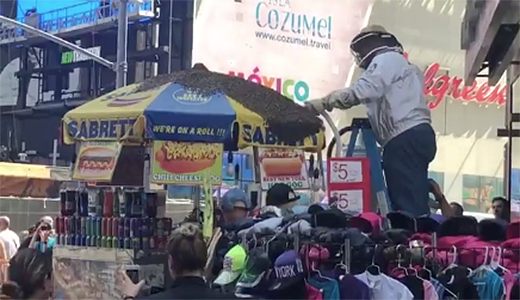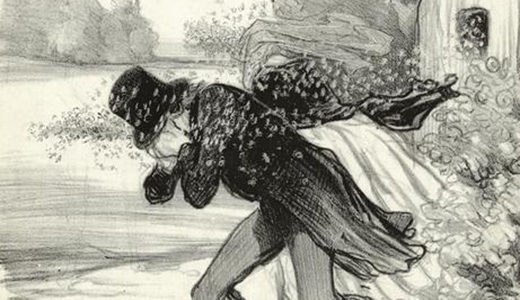 2018
2018
From PIX 11 footage of the Times Square bee vacuuming of 2018.
On the afternoon of August 28, a swarm of bees attacked the umbrella of a Sabrett hot dog stand at Broadway and West 43rd Street in Times Square, compelling the NYPD beekeeper to come, vacuum in hand, to remove them from the scene. The fact that the NYPD has its own bee guy might make obvious that this is a less than rare, if always attention-grabbing, occurence. And, according to former NYPD beekeeper Tony Bees, there is an art to it: “Something like this, timing is of an essence. You have to hit them fast and hit them hard. You don't let them know you're there.” From the New York Post:
NYPD Sgt. Timothy Sheldo said at the scene “a bunch” of the flying insects were initially spotted “swarming” around the pedestrian plaza at nearby Military Island. “People were just swatting in front of their faces,” he said.
Officer Michael Lauriano—known as the NYPD’s “Bee Guy”—donned protective gear, including a netting over his face, as he stood on a ladder and sucked up the bees with a special vacuum device.
Lauriano, an eighteen-year NYPD veteran, had the majority of the bees collected in a matter of minutes.
“We try to get as many as we can,” Lauriano said. “We like to keep the families together.”
Lauriano couldn’t immediately say where the massive group of bees would be taken, but noted that officials will find them a hive.
“We’ve got to determine [where to take them], but definitely in a hive,” Lauriano said.
The bee scene turned into a tourist attraction, with passersby snapping photos and shooting videos.
“Look at all those darn bees!” David Volger, forty-five, said as he live-streamed the incident on his cell phone.
 1906
1906
Man and Woman Being Chased by Bees (detail), by Honoré Daumier. The New York Public Library, Art and Picture Collection.
The horrifyingly large bee swarm has always been newsworthy. In 1901 thousands of bees spent their lunch hour on a busy street in Poughkeepsie: “People stood on the sidewalks at a safe distance and laughed at the antics of the unfortunate victims of bee stings. The queen of the swarm finally collected her cohorts on a trolley pole, and from there they were coaxed to a hive.” In 1892 bees boarded a train leaving Newark and congregated in the baggage car, as employees unsuccessfully tried to dispatch them into the wind through an open door. After bees took over a street in Baltimore, one newspaper concluded, “Where the bees came from is not known, but their presence in the heart of the city was a most unusual circumstance.” And one day in April 1906, the Los Angeles Times watched as a swarm orchestrated a hullabaloo:
Globe trotters often call attention to the similarity of Southern California to the Holy Land; here's another confirmation. While Los Angeles cannot be said to literally have a flow of milk and honey, it at least showed something doing in that line yesterday. A great colony of honeybees was struck by the desire to move, at noon, and the bees swarmed out until the air was filled with their buzzing.
Finally the queen settled on the cornice of the old-fashioned wooded awning, and there, in a few moments, gathered the seething, whirring mass of insects. At times it became so unwieldy that sections of it would fall off. Bunches of bees as large as a baseball would break off from the swarm and drop toward the street surface; but always the bees separated and took wing before striking the pavement. The sight was novel and attracted a large crowd. Right in the midst of it all a milk wagon drove up, and the driver was so entranced with the excitement he could scarcely break away. In truth it was an incident of milk and honey.
When the bees were swarming last year a ranchman happened along and offered the owner of the upper-floor lease $10 for the swarm. Gladly the money was taken. But, alas, for the ranchman, it was like buying a bird in the air. When he had his arrangements completed for hiving the bees they took a sudden notion to start awing, and never were they heard of again.